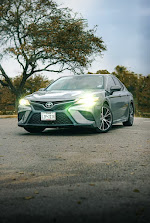To most
owners of an automatic transmission car, it's all about hopping into your car,
starting the engine, and shifting the gear lever, the rest they say is
automated, with no clutching and no revving as opposed to the manual transmission, quite
interesting though.
Yes, the
clutch might be absent in the automatic transmission, but the whole system of
propelling the car is done via the same old process.
A
torque converter is to an automatic transmission what a clutch is to a manual
transmission, both devices carry out the same process in seemingly different
ways, NOW YOU KNOW YOUR AUTO TRANNY IS NOT ALL AUTO ANYWAYS!
In
simple language, a torque converter is a mechanical device responsible for
transferring rotating power generated by an engine to a transmission via the hydraulic process.
Instead
of the clutch fitted in a manual transmission, the torque converter is fitted
in the automatic transmission to achieve the same
result.
result.
While
the clutch achieves its motive by physically connecting to the transmission
shaft via the use of gears, the torque converter usually does its job by using a
hydraulic process.
HOW
DOES THE TORQUE CONVERTER WORK?
The
torque converter is made up of three main components
1. The
impeller
2. The turbine
3. The Stator
The
impeller or pump which is directly connected to the engine spins at the same speed
as the engine, the impeller when spinning by virtue of its design(with fins
inside) directs hydraulic fluids to the turbine(connected to the transmission) which allows it to spins at an opposite direction at almost
a similar speed, a practical example is achieved when two standing fans are
brought together in the same room facing each other, one of the fans is powered on
to spin, the resultant effect is that the other facing it would turn at a
different direction at almost the same speed, this is achieved using the air
generated by the powered fan, in the case of the torque converter this is
achieved using the hydraulic fluid enclosed within it. in a nutshell, the
impeller which spins the turbine using the hydraulic fluid allows the
transmission to rotate and ultimately drives the car without any physical
contact between both components this is because the turbine is directly connected to the transmission.
THE
STATOR
The
stator which is the third component in the torque converter is responsible for
the reverse movement of the hydraulic fluid from the direction of the turbine to that of the
impeller.
When
the hydraulic fluid from the impeller is directed to the turbine it goes back
to the direction of the impeller through the stator.
This gives us an idea of how the torque converter really works.
This gives us an idea of how the torque converter really works.
SIGNS
OF A FAULTY TORQUE CONVERTER
Sometimes
your automatic transmission car might begin to act up and you might wonder what
the problem is, a torque converter when faulty can affect the way your car
might generally run, here are a few tail signs that you might have a faulty
torque converter.
OVERHEATING
Yes
overheating is a common sign of a faulty torque converter this is always
attributed to low fluid levels or malfunctioning solenoids
TRANSMISSION
SLIPPAGE
Transmission
slippage could also be a sign of a
malfunctioning torque converter, this occurs when little or no fluids are passed
to the transmission this could cause gears to slip and will result in a loss of
acceleration.
INCREASED
STALL SPEED
When
the torque converters go bad, it takes the transmission longer to engage
the engine, leading to higher than normal stall speed.
MESSY
FLUID
Messy fluid could also be a pointer that your torque is packing up. When
you check your transmission fluid and discover that there are particles of
large black materials this means that the transmission or torque converter
clutches are bad.
SHUDDERING
When
it feels like you are running over bumps or rough roads at 30 to 50 mph when
driving then its time to have a look at your torque converter, a faulty
torque converter can make you feel like you are running on a rough road when in
actual sense you are not.
STRANGE
REVVING SOUND
A
strange revving or clicking sound is also a potential sign of a faulty torque
converter.
CAUSES
OF TORQUE CONVERTER PROBLEMS
Torque
converter problems could vary from
DAMAGED TORQUE CONVERTER CLUTCHES
Damaged torque converter clutches are a common problem, automatic transmissions also are equipped with clutches like the manual transmission these clutches are usually located throughout the transmission, these clutches go bad when they become jammed due to distortions or if they are burnt.
When this happens the vehicle stays stuck in gear.
DAMAGED NEEDLE BEARING
Needle bearings are the components that separate the turbine, impeller, and stator, the resultant effect of them going bad is a rattling sound from the transmission
DAMAGED TORQUE CONVERTER SEAL
A damaged torque converter seal allows fluid to leak out of the torque converter, which could ultimately lead to several problems like overheating, and slippage
In all of this having your tech person properly inspect your car whenever you notice any of these anomalies should be the ideal thing to do. ensuring your torque remains in good condition is paramount to ensuring your car remains on the road for quite a long time to come.
In all of this having your tech person properly inspect your car whenever you notice any of these anomalies should be the ideal thing to do. ensuring your torque remains in good condition is paramount to ensuring your car remains on the road for quite a long time to come.
Tags:
Repair And Maintenance
